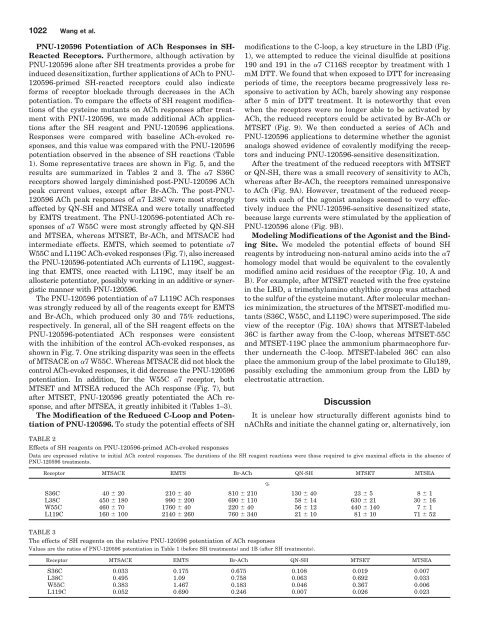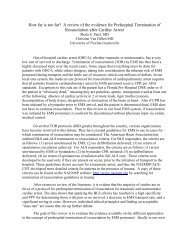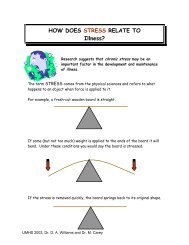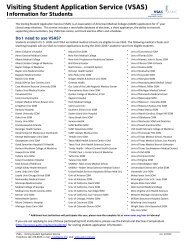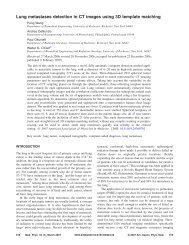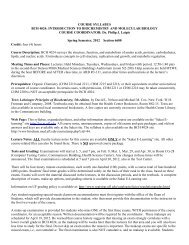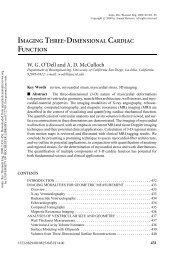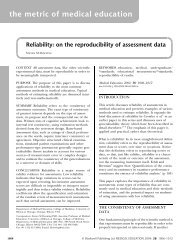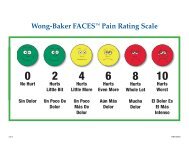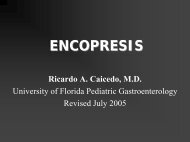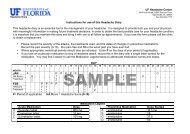PHARMACOLOGY - Laboratory of Dr. Roger L. Papke - University of ...
PHARMACOLOGY - Laboratory of Dr. Roger L. Papke - University of ...
PHARMACOLOGY - Laboratory of Dr. Roger L. Papke - University of ...
Create successful ePaper yourself
Turn your PDF publications into a flip-book with our unique Google optimized e-Paper software.
1022 Wang et al.PNU-120596 Potentiation <strong>of</strong> ACh Responses in SH-Reacted Receptors. Furthermore, although activation byPNU-120596 alone after SH treatments provides a probe forinduced desensitization, further applications <strong>of</strong> ACh to PNU-120596-primed SH-reacted receptors could also indicateforms <strong>of</strong> receptor blockade through decreases in the AChpotentiation. To compare the effects <strong>of</strong> SH reagent modifications<strong>of</strong> the cysteine mutants on ACh responses after treatmentwith PNU-120596, we made additional ACh applicationsafter the SH reagent and PNU-120596 applications.Responses were compared with baseline ACh-evoked responses,and this value was compared with the PNU-120596potentiation observed in the absence <strong>of</strong> SH reactions (Table1). Some representative traces are shown in Fig. 5, and theresults are summarized in Tables 2 and 3. The 7 S36Creceptors showed largely diminished post-PNU-120596 AChpeak current values, except after Br-ACh. The post-PNU-120596 ACh peak responses <strong>of</strong> 7 L38C were most stronglyaffected by QN-SH and MTSEA and were totally unaffectedby EMTS treatment. The PNU-120596-potentiated ACh responses<strong>of</strong> 7 W55C were most strongly affected by QN-SHand MTSEA, whereas MTSET, Br-ACh, and MTSACE hadintermediate effects. EMTS, which seemed to potentiate 7W55C and L119C ACh-evoked responses (Fig. 7), also increasedthe PNU-120596-potentiated ACh currents <strong>of</strong> L119C, suggestingthat EMTS, once reacted with L119C, may itself be anallosteric potentiator, possibly working in an additive or synergisticmanner with PNU-120596.The PNU-120596 potentiation <strong>of</strong> 7 L119C ACh responseswas strongly reduced by all <strong>of</strong> the reagents except for EMTSand Br-ACh, which produced only 30 and 75% reductions,respectively. In general, all <strong>of</strong> the SH reagent effects on thePNU-120596-potentiated ACh responses were consistentwith the inhibition <strong>of</strong> the control ACh-evoked responses, asshown in Fig. 7. One striking disparity was seen in the effects<strong>of</strong> MTSACE on 7 W55C. Whereas MTSACE did not block thecontrol ACh-evoked responses, it did decrease the PNU-120596potentiation. In addition, for the W55C 7 receptor, bothMTSET and MTSEA reduced the ACh response (Fig. 7), butafter MTSET, PNU-120596 greatly potentiated the ACh response,and after MTSEA, it greatly inhibited it (Tables 1–3).The Modification <strong>of</strong> the Reduced C-Loop and Potentiation<strong>of</strong> PNU-120596. To study the potential effects <strong>of</strong> SHmodifications to the C-loop, a key structure in the LBD (Fig.1), we attempted to reduce the vicinal disulfide at positions190 and 191 in the 7 C116S receptor by treatment with 1mM DTT. We found that when exposed to DTT for increasingperiods <strong>of</strong> time, the receptors became progressively less responsiveto activation by ACh, barely showing any responseafter 5 min <strong>of</strong> DTT treatment. It is noteworthy that evenwhen the receptors were no longer able to be activated byACh, the reduced receptors could be activated by Br-ACh orMTSET (Fig. 9). We then conducted a series <strong>of</strong> ACh andPNU-120596 applications to determine whether the agonistanalogs showed evidence <strong>of</strong> covalently modifying the receptorsand inducing PNU-120596-sensitive desensitization.After the treatment <strong>of</strong> the reduced receptors with MTSETor QN-SH, there was a small recovery <strong>of</strong> sensitivity to ACh,whereas after Br-ACh, the receptors remained unresponsiveto ACh (Fig. 9A). However, treatment <strong>of</strong> the reduced receptorswith each <strong>of</strong> the agonist analogs seemed to very effectivelyinduce the PNU-120596-sensitive desensitized state,because large currents were stimulated by the application <strong>of</strong>PNU-120596 alone (Fig. 9B).Modeling Modifications <strong>of</strong> the Agonist and the BindingSite. We modeled the potential effects <strong>of</strong> bound SHreagents by introducing non-natural amino acids into the 7homology model that would be equivalent to the covalentlymodified amino acid residues <strong>of</strong> the receptor (Fig. 10, A andB). For example, after MTSET reacted with the free cysteinein the LBD, a trimethylamino ethylthio group was attachedto the sulfur <strong>of</strong> the cysteine mutant. After molecular mechanicsminimization, the structures <strong>of</strong> the MTSET-modified mutants(S36C, W55C, and L119C) were superimposed. The sideview <strong>of</strong> the receptor (Fig. 10A) shows that MTSET-labeled36C is farther away from the C-loop, whereas MTSET-55Cand MTSET-119C place the ammonium pharmacophore furtherunderneath the C-loop. MTSET-labeled 36C can alsoplace the ammonium group <strong>of</strong> the label proximate to Glu189,possibly excluding the ammonium group from the LBD byelectrostatic attraction.DiscussionIt is unclear how structurally different agonists bind tonAChRs and initiate the channel gating or, alternatively, ionTABLE 2Effects <strong>of</strong> SH reagents on PNU-120596-primed ACh-evoked responsesData are expressed relative to initial ACh control responses. The durations <strong>of</strong> the SH reagent reactions were those required to give maximal effects in the absence <strong>of</strong>PNU-120596 treatments.Receptor MTSACE EMTS Br-ACh QN-SH MTSET MTSEA%S36C 40 20 210 40 810 210 130 40 23 5 8 1L38C 450 180 990 200 690 110 58 14 630 21 30 16W55C 460 70 1760 40 220 40 56 12 440 140 7 1L119C 160 100 2140 260 760 340 21 10 81 10 71 52TABLE 3The effects <strong>of</strong> SH reagents on the relative PNU-120596 potentiation <strong>of</strong> ACh responsesValues are the ratios <strong>of</strong> PNU-120596 potentiation in Table 1 (before SH treatments) and 1B (after SH treatments).Receptor MTSACE EMTS Br-ACh QN-SH MTSET MTSEAS36C 0.033 0.175 0.675 0.108 0.019 0.007L38C 0.495 1.09 0.758 0.063 0.692 0.033W55C 0.383 1.467 0.183 0.046 0.367 0.006L119C 0.052 0.690 0.246 0.007 0.026 0.023


